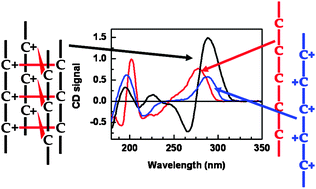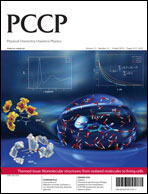In this work we have recorded synchrotron radiation circular dichroism (SRCD) spectra from 180 nm to 360 nm of cytosine strands [(dC)n, n = 1, 2, …, 10] in aqueous solution at different pH values to reveal electronic coupling between bases in different ionisation states. The geometry of the strands is determined by the pH value and the strand length and the local organisation of the cytosines will determine the base-to-base interaction that impacts on the CD signal. At low pH where all bases are protonated, there is no signature of electronic coupling between the bases, and the SRCD spectrum is simply n times that of the n = 1 spectrum. At higher pH where all bases are neutral, the spectra for n > 1 differ from the monomer spectrum, which implies electronic coupling between bases. The correlation between the CD signal and n is linear, and the spatial extent of the excited state wavefunction is therefore over just two stacked bases both in the UV and VUV. At intermediate pH, the low-n spectra are different from the high-n spectra, and a transition is seen to occur at n = 6–8. We ascribe this behavior to the formation of i-motif structures between four (dC)n strands for high n.

You have access to this article
 Please wait while we load your content...
Something went wrong. Try again?
Please wait while we load your content...
Something went wrong. Try again?


 Please wait while we load your content...
Please wait while we load your content...